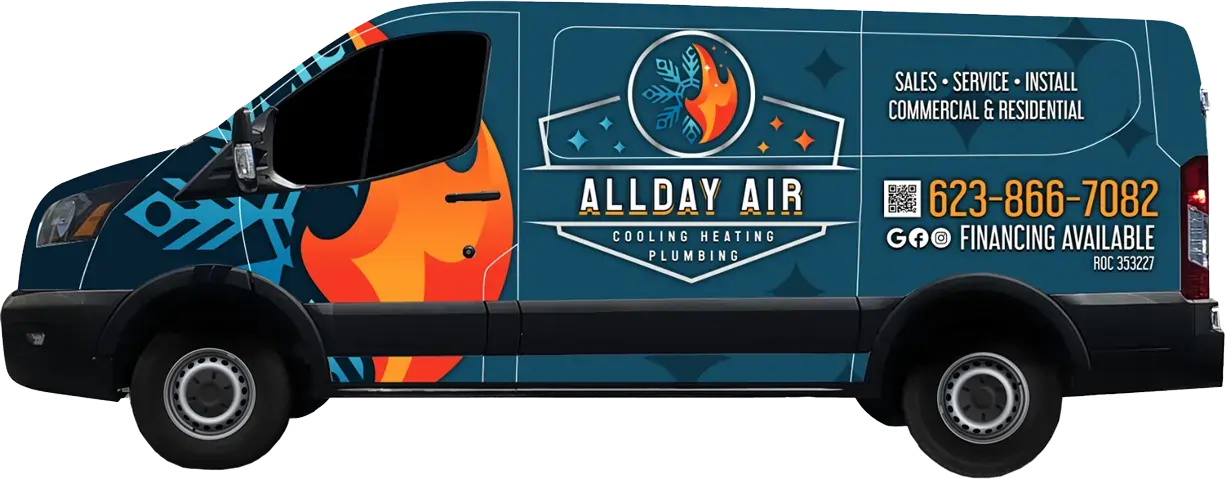Common AC Repair Issues and How to Spot Them
"*" indicates required fields
Recognizing Refrigerant Leaks in Your Air Conditioning System
When your air conditioner starts struggling to keep your home cool despite running constantly, you might be dealing with a refrigerant leak. This issue accounts for approximately 10% of all AC repair calls nationwide and can significantly impact your system’s efficiency. At AllDay Air, we’ve diagnosed countless refrigerant leaks since our founding in 2016, and we know exactly what signs indicate this problem. You’ll notice warm air blowing from vents even when the thermostat is set to cool, ice forming on the evaporator coils, or hissing sounds coming from the indoor unit. These symptoms occur because low refrigerant levels prevent proper heat absorption, forcing your system to work harder while delivering less cooling power.
The environmental impact of refrigerant leaks extends beyond comfort concerns. Modern refrigerants like R-410A operate at pressures exceeding 400 PSI, making even small leaks problematic for both system performance and environmental safety. Our experienced technicians use electronic leak detectors and UV dye testing to pinpoint exact leak locations, whether they’re in copper line sets, evaporator coils, or connection points. Addressing refrigerant leaks promptly prevents compressor damage, which can cost thousands of dollars to replace. We ensure that your system is running efficiently and effectively by performing thorough leak repairs and proper refrigerant charging according to manufacturer specifications.
Electrical Component Failures and Warning Signs
Electrical problems represent nearly 25% of air conditioner repair needs, ranging from simple capacitor failures to complex control board malfunctions. Your AC system relies on numerous electrical components working in harmony, including contactors, relays, capacitors, and circuit boards. When these components begin failing, you’ll experience symptoms like frequent circuit breaker trips, systems that won’t start, or units that cycle on and off rapidly. Start capacitors, which provide the initial power surge needed to start your compressor, typically last 5-7 years before requiring replacement. Run capacitors maintain consistent power flow during operation and may show signs of failure through bulging cases or oil leaks.
Our team of highly skilled professionals understands that electrical issues require immediate attention to prevent cascading failures throughout your system. Worn contactors can cause voltage irregularities that damage expensive components like compressor motors or fan motors. Control board failures often manifest as erratic system behavior, incorrect temperature readings, or complete system shutdowns. We take pride in our commitment to excellence when diagnosing these complex electrical issues, using advanced multimeters and diagnostic tools to verify proper voltage, amperage, and resistance values throughout your system’s electrical circuits.
Identifying Compressor Problems Before Complete Failure
The compressor serves as your air conditioning system’s heart, circulating refrigerant through the entire cooling cycle. Compressor issues develop gradually, providing warning signs that knowledgeable homeowners can recognize early. You might hear unusual noises like grinding, squealing, or loud humming sounds emanating from your outdoor unit. These sounds indicate internal wear, bearing failure, or electrical problems within the compressor motor. Temperature inconsistencies between rooms, longer cooling cycles, or complete inability to reach set temperatures all point to compressor strain.
Common Drainage and Condensate Line Issues
Your air conditioner removes significant moisture from indoor air, producing several gallons of condensate daily during peak cooling season. This water must drain properly through condensate lines and drain pans, but blockages from algae, mold, or debris create serious problems. Water damage from overflowing drain pans can destroy ceilings, walls, and flooring while creating ideal conditions for mold growth. We are committed to offering energy-efficient solutions that include regular condensate line cleaning and treatment to prevent these costly issues.
- Standing water around indoor unit: Indicates blocked primary drain line requiring immediate clearing
- Musty odors from vents: Suggests mold growth in drain pans or ductwork from excess moisture
- Water stains on ceilings or walls: Shows overflow situations requiring both repair and preventive measures
- Gurgling sounds from drain lines: Indicates partial blockages that will worsen without intervention
Recognizing Airflow Restrictions and Their Impact
Proper airflow is essential for efficient cooling and system longevity. Restrictions force your equipment to work harder, increasing energy consumption by up to 30% while reducing comfort levels. Dirty air filters remain the most common culprit, but ductwork problems, closed vents, or failing blower motors create similar issues. Customer satisfaction is our top priority at AllDay Air, which is why we thoroughly evaluate entire airflow systems during AC service calls.
When airflow problems persist, you’ll notice uneven cooling throughout your home, excessive dust accumulation, or frozen evaporator coils. Our innovative engineers have developed comprehensive diagnostic procedures to identify restrictions anywhere in your system. We back our work with warranties because we’re confident in our ability to restore proper airflow and system efficiency. Don’t wait until minor airflow issues cause major component failures—early intervention saves money and extends equipment life significantly.
Schedule Service
"*" indicates required fields























